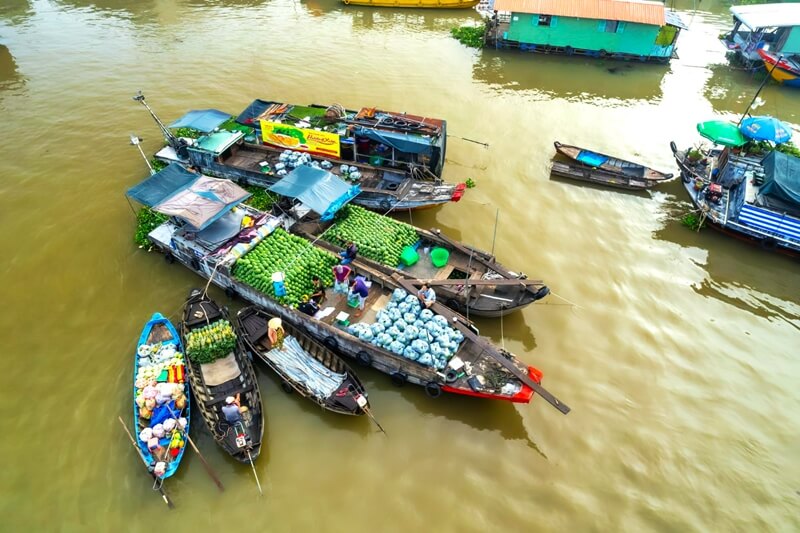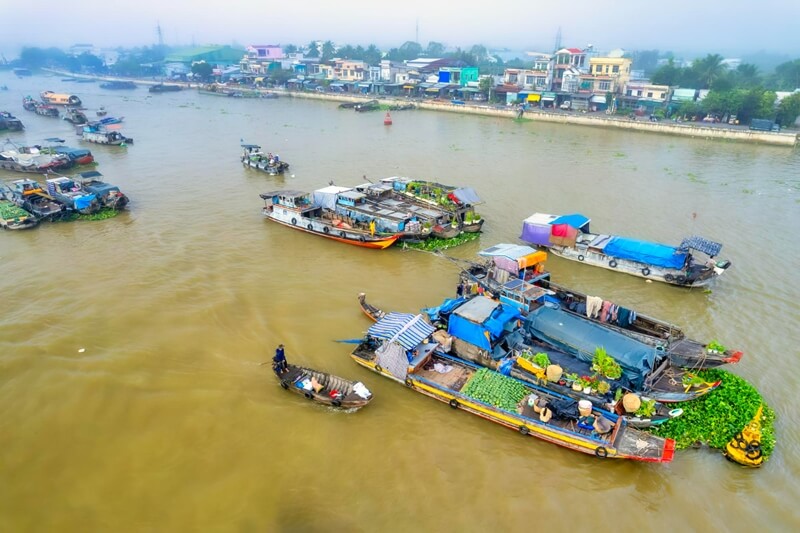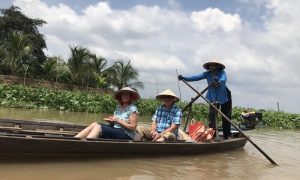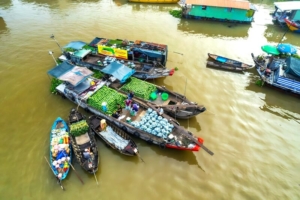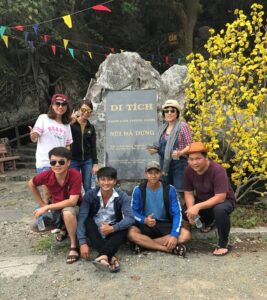The Mekong Delta on the Vietnam map includes the provinces of Long An, Tien Giang, Ben Tre, Vinh Long, Tra Vinh, Can Tho, Soc Trang, Bac Lieu, Ca Mau, Kien Giang, An Giang, Dong Thap and Hau Giang.
The region’s total natural area is nearly 40 km2, 12.2% of the country’s natural area.
Population: ~ 18,590,400 people
Ethnic groups: Viet (Kinh), Khmer, Hoa, and Cham
Mekong Delta is a special economic-cultural area of the South of Vietnam. It combines with Ho Chi Minh City, creating an important tourist area to explore Vietnam.
Geography, natural conditions of the Mekong Delta
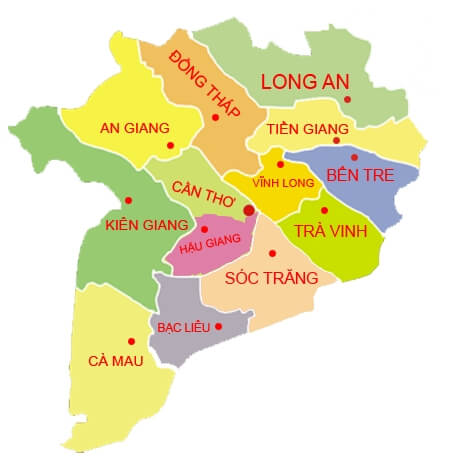
Geographical location
The Mekong Delta is located in the southwest of the country, at the end of the Indochina peninsula, adjacent to the Key Economic Zone of South Vietnam. Many Vietnamese call this region “Miền Tây,” meaning the Southern part.
It is bordered by Cambodia and the same Mekong River, which creates good conditions for cooperation with countries in the Indochina peninsula.
The Mekong Delta also has a 73.2 km long coastline and many islands, such as Tho Chu and Phu Quoc, in the East Sea and the Gulf of Thailand.
The region is in the area of international maritime and air traffic between South Asia and Southeast. This position is critical in global exchanges.
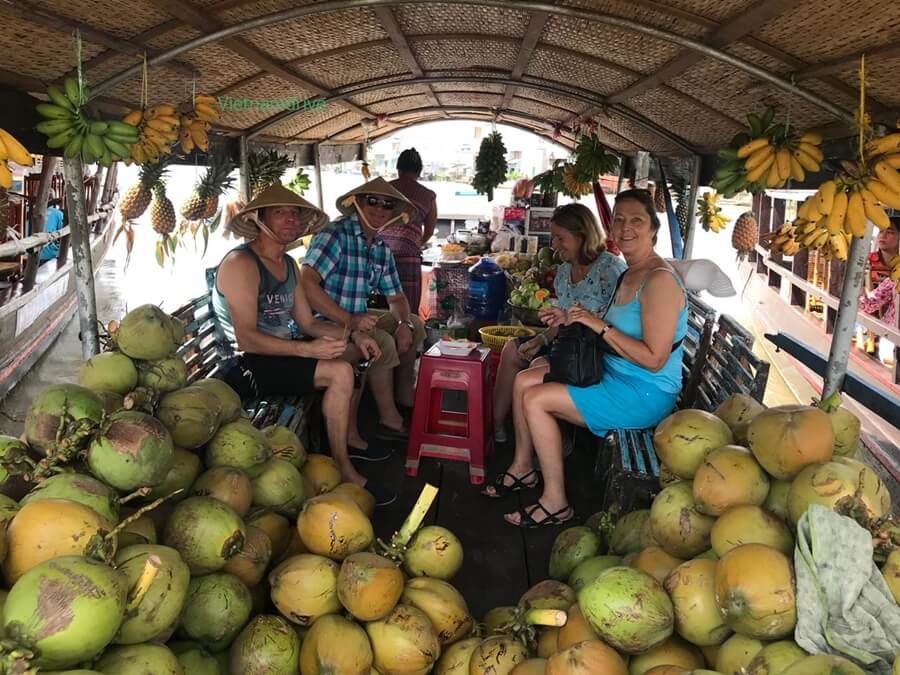
Natural conditions and resources
Topographic of Mekong Delta:
The Mekong Delta of Vietnam is formed from sediment and accretion caused by the changing sea level; at each stage, sand dunes form along the coast.
The mixed activities of the river and the sea have formed fertile alluvial lands along the river and the coast.
The area’s topography is relatively flat. The average height is 3-5m, and the area is only 0.5 – 1m above sea level.
Climate in Mekong Delta:
The humid tropical climate with equatorial equilibrium is evident. The annual average temperature is 24 – 27 degrees Celsius, and the difference in day and night temperature is low.
There are two seasons: the rainy season is from May to October, and rainfall accounts for 99% of the total rainfall of the year; the dry season is from December to April of the next year, and there is almost no rain.
The region’s climatic factors are suitable for organisms to grow and develop, which is good for agriculture.
Land Conditions:
– The land conditions of the Mekong Delta include:
+ Alluvial soil: Mainly distributed in the coastal zone and between the system of the Tien River and the Hau River. The area has 1.2 million hectares of alluvial soil. This soil group is highly fertile and suitable for rice, fruit, and short-term industrial trees.
+ Acidic soil: distributed in Dong Thap Muoi and Ha Tien. These are the central lowlands of Ca Mau, with a total area of 1.2 million hectares. The soil is poor.
+ Gray soil: includes an area of 134,000 ha. It covers mainly along the Cambodian border, on the ancient alluvium floor of the Dong Thap Muoi. This kind of land has light soil, is spongy, and has low fertility.
+ Other soil groups, such as sandy soil, red soil, and erosion soil, occupy 0.9% of the area.
In general, the land here is very favorable for agricultural development, suitable for growing rice, coconut, sugarcane to make sugarcane juice and sugar, pineapple and fruit trees.
Water Resources:
The Mekong Delta in Vietnam is in the lower Mekong system, including the Tien and Hau rivers, which have 500 billion cubic meters. The Tien River accounts for 79%, and the Hau River accounts for 21%.
The hydrological regime varies seasonally. The rainy season in September and October usually causes floods in Dong Thap Muoi and Long Xuyen. During this season, river water brings a lot of silt to the plain.
The amount of water is lower in the dry season. The tides come into the deltas, causing salty soils.
Marine resources:
– Coast length: 732 km with many estuaries and bays. There are many kinds of seafood: Shrimp, turtles and squids.
– Many islands have high economic potential, such as Tho Chu and Phu Quoc islands.
Mineral resources:
– The mineral reserves are not much; however, limestone is distributed in Ha Tien, Kien Luong, with around 145 million tons.
This limestone is used for the production of cement and lime. The sand is at Vam Co River, and the Mekong River has about 10 million cubic meters; the peat is in U Minh, Can Tho, Soc Trang, and Long Xuyen.
>> Would you like to read about the coconut worms typical in the Mekong Delta?
Which is special to see in the Mekong Delta?
Besides many rivers in the Mekong Delta, there are national parks, bird sanctuaries, botanical gardens with countless birds and precious plants and animals such as Tram Chim National Park, Thap Muoi Garden (Dong Thap); National Park of Phu Quoc (Kien Giang); Vam Ho bird sanctuary (Ben Tre); Bac Lieu bird sanctuary; National parks U Minh Thuong and U Minh Ha, Nam An mangrove forest, Cha La bird sanctuary, Dam Doi, and Ngoc Hien (Ca Mau).
The Mekong Delta also attracts visitors with many colorful flower farms and fruit gardens, such as Sa Dec (Dong Thap), Thanh Tam (Long An), or Cai Mon (Ben Tre). Floating markets in the Mekong Delta make this land unique. They are the early morning market Phung Hiep (Hau Giang), Cai Be floating market (Tien Giang), Nga Nam (Soc Trang), or Cai Rang floating market (Can Tho).
Besides, there are many islets year-round with sunshine and fresh nature, such as Phung-Quy-Tien (Ben Tre), My Phuoc (Soc Trang), or Thoi Son (Tien Giang).
In addition, traditional folk festivals have unique cultural identities, such as the festival of the Lord Mountain of Sam Mountain, the Ook om bok festival, the boat race, or the Seven Mountain race.
Visitors to the Mekong Delta have the opportunity to enjoy traditional folk songs such as Cai Luong or the Khmer dance.
If you like to experience a different way of life on the water, you should visit the Mekong Delta to explore its typical life and culture.
